Sea snakes of Okinawa

The other tubular citizens on the reef are gill bearing fish, but the sea snake is a true air breathing reptile. The sea snake can hold his breath for long periods while hunting and even sleeping on the reef, but must eventually come to the surface for a quick breath of air. This behavior can scare the devil out of curious divers as the snake will often swim directly at a hovering diver on the way to the surface. They mate and birth their young on the shore, but spend the rest of their lives hunting fish, crustaceans and eels amongst the nooks and crannies of the reef. I have often followed snakes as they made their rounds along a reef and their persistence (not to mention breath holding ability) is truly amazing.
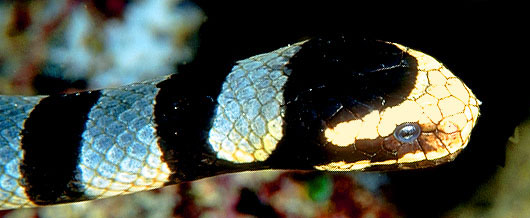
Sea snakes are one of the most poisonous creatures on the reef with a venom similar to that of the cobra. Fortunately, these fellows are not that aggressive except when you try to play with them when they are trying to get a fresh breath of air. In addition to their mellow nature, they have short fangs unlikely to penetrate even a tropical wet suit and seldom envenomate even with biting. There have been deaths reported, but these were usually fishermen encountering the snakes in their nets. They have poor eyesight, but excellent chemical sensation and have the same forked tongue as their land based cousins for sensing vibration.
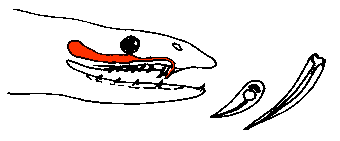
Sea snakes have specialized flattened tails for swimming and have valves over their nostrils which are closed underwater. They differ from eels in that they don't have gill slits and have scales. Due to their need to breathe air, they are usually found in shallow water where they swim about the bottom feeding on fish, fish eggs and eels.
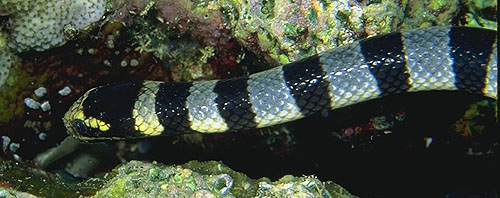
Aggressive only during the mating season in the winter, the sea snake is very curious, and they become fascinated by elongated objects such as high pressure hoses. Provoked snakes can become very aggressive and persistent requiring repeated kicks from the fins, the Coast Gaurd and a Marine Infantry Platoon to ward them off.
The yellow-bellied sea snake ( Pelamis platurus ) is planktonic, and is seen on occasions floating in massive groups. Fish that come up to shelter under these slicks provide food for the snakes. Occasionally these yellow-bellies get washed up on beaches after storms and pose a hazard to children.
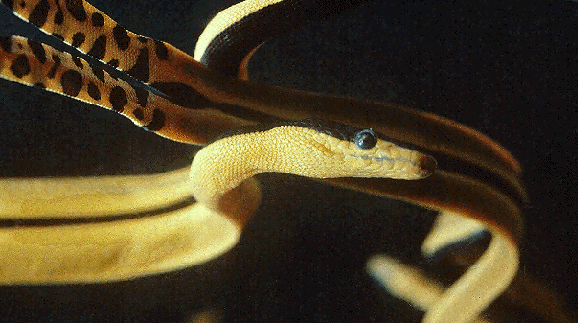
Persistent myths about sea snakes include the mistaken idea that they can't bite very effectively. The truth is that their short fangs (2.5-4.5mm) are adequate to penetrate the skin, and they can open their small mouths wide enough to bite a table top. It is said that even a small snake can bite a man's thigh. Sea snakes can swallow a fish that is more than twice the diameter of their neck.
Most sea snake bites occur on trawlers, when the snakes are sometimes hauled in with the catch. Only a small proportion of bites are fatal to man, as the snake can control the amount of envenomation, a fact probably accounting for the large number of folk cures said to be 95% effective.
Intense pain is not obvious at the site of the sea snake bite; 30 minutes after the bite there is stiffness, muscle aches and spasm of the jaw followed by moderate to severe pain in the affected limb. There follows progressive CNS symptoms of blurred vision, drowsiness and finally respiratory paralysis. A specific antivenin is available; if not obtainable-the Australian tiger snake antivenin or even polyvalent snake antivenin can be used.
There is no known antivenom for the Yellow Bellied Sea Snake's bite.
Although an eel and sea snake look very similar there are some remarkable differences between them.
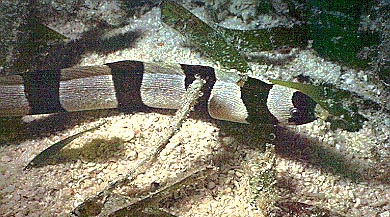
Eels are fish and use gills to breathe, whereas sea snakes are reptiles and use their lungs. Most sea snakes have a paddle like tail, which they use to propel themselves through the water. Sea snakes also moult their skin frequently to grow and to aid in the removal of parasites from their skin.
Sea snakes are air breathing reptiles, which all have venom glands and fangs to capture prey, including some species which are dangerous to humans. Eels are not venomous, although they can give a nasty bite while protecting their territory. 30% of air is absorbed through their skin from the water via osmosis
***Distribution
There are over 50 species of marine snakes in the world, and with few exceptions they are generally confined to the tropical areas of the Indian and Pacific oceans moving up to the Persian Gulf, throughout Asia, and extending from Africa to America, from Siberia to Tasmania. It should be noted however that sea snakes are not found in the Atlantic Ocean. In Australian waters, 38 species can be found, and 11 of these species are endemic to Australia.
***Food and Nutrition
Sea snakes are separated into two sub-divisions according to feeding behaviour.
- Bottom Feeders - refers to sea snakes that dive to depths of approximately 100 metres to locate and devour prey such as eels and fish, and also to raid burrows for fish eggs.
- Pelagic Feeders - are surface feeders and drift with the warm tides.
***Predators
Sea snakes are top predators yet they still have their enemies including sea eagles, sharks, moray eels, fish, saltwater crocodiles, crabs and humans.
Sea snakes are often caught as by-catch during the prawning season and are used as food (this includes their eggs, meat and oil), leather and in medicine (alcoholic spirits). In Asian culture the meat from a sea snake is believed to be an aphrodisiac.
***Adaptations to life in the sea
Through evolutionary time the land snake evolved into the sea snake. It achieved this in a number of ways, including
- Developing salt excreting glands under the tongue.
- Developing a flattened paddle-shaped tail and a laterally compressed body making it an efficient swimmer.
- Reducing its metabolic rate. Sea snakes are capable of remaining submerged for up to 2 hours by decreasing its metabolic rate and developing an increased tolerance for low oxygen levels. After one breath at the surface, it can dive again. A sea snake also has valve-like flaps over its nostrils to stop water flowing into the lungs.
- The lungs of sea snakes are greatly enlarged, extending to the base of the tail enabling a large volume of oxygen to be stored in the lungs.
- Parts of the lung are believed to function as a hydrostatic organ regulating the snake's buoyancy.
- Gaseous exchange occurs through both the lungs and the skin. Up to 22% of the oxygen is supplied from the sea water through the skin and all excess carbon dioxide is lost into the sea.

***Reproduction
There are two methods of reproduction.
- The sea snake may mate and lay their eggs onshore in crevices or caves. These eggs are capable of existing for long periods of time out of the water, or
- The sea snake may mate at sea and give birth to live young.
***Venom
The venom of a sea snake is approximately two to ten times as toxic as that of a cobra. However, due to poorly developed delivery apparatus, very little venom is actually delivered when the sea snake bites. Because of this, only about one quarter of people bitten by sea snakes ever show signs of poisoning. In sea snakes the fangs lie at the back of the mouth whereas in land snakes they are positioned at the front.
Bites often remain unnoticed due to the absence of, or, very little pain being experienced and little swelling or inflammation occurring. Also, fang marks are sometimes barely visible. There are usually four fang marks on the victim, however there may be as few as one or as many as twenty. Sometimes the fangs may remain in the wound.
When the snakes are in relatively cold seas, they do not survive for long and are usually cast up dead or dying on beaches by winter storms. Care should be taken with stranded sea snakes - although lethargic and immobile, they could still be capable of a lethal bite.
***Interesting Facts
The main identifying characteristic between sea snakes and land snakes is that sea snakes have a flattened tail.
Sea snakes are inquisitive and sometimes aggressive creatures, especially if handled or trodden upon. They are also attracted to fast moving objects, such as divers towed behind boats.
With the ability to dive to depths of 100 metres this reptile can remain underwater for approximately 2 hours depending on the type of activity the snake is doing.
Some species are unable to tolerate extremes of temperature. The upper lethal limit for the sea snakes body temperature is 33 - 36�C. Sea snakes avoid high temperatures by diving into cooler water away from the surface when it is travelling in tropical regions. It is for this reason they are found on the surface during rain on cloudy days.
There are some eels, especially snake eels that are frequently confused with snakes. Look at the photo below and it easily understood why. Not only are the patterns very similar, but the snake eel also moves like a snake. However on close inspection it is easy to tell them apart. Sea snakes have scales and no fins on their back. Snake eels have a gill opening behind their head and large nostrils. The Snake eel mimics the sea snake, because this gives them some protection against predators.

***Snakes for the Gourmet
Over the ages and all over the world, people of both past and present have considered the flesh of snakes to have magical properties, serving as medicine or, in the case of a Manila restaurant, Mariposa de la Vida (Butterfly of Life), as an aphrodisiac. The guest may select a live sea snake from the management's aquarium and have an "exotic" dish prepared from it, to be served at his table. In other parts of the world, some customers would order a live specimen, slit its throat, and drink the blood. Following this aperitif, the still-wriggling snake was diced and eaten raw, with soy sauce.
For the true gourmet, there is an entree called Sea Snake Adobo. The sliced meat is soaked in vinegar, then in soy sauce mixed with a combination of pimento and garlic, for fifteen minutes. The mixture is then boiled in a solution of soda for a half-hour, after which it is drained, fried and garnished with pickles, onions, and tomato al gusto. An alleged aphrodisiac, though to the weak of stomach more likely an emetic, the gall bladder is chugalugged with a glass of wine. In the case of a non-drinker, three dried gall bladders may be blended in coffee and then consumed. Yummy!
***Commonly seen around Okinawa
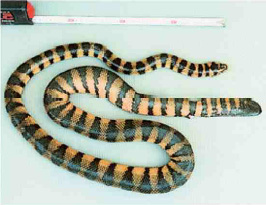
- JAPANESE NAME : Madara-Umi-Hebi
- COMMON NAME : Banded sea snake
- SCIENTIFIC NAME : Hydrophis cyanocinctus
- LENGTH : 110 - 180cm
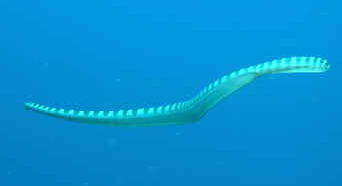
- JAPANESE NAME : Kuro-Boshi-Umi-Hebi
- COMMON NAME : Ryukyu ornated sea snake
- SCIENTIFIC NAME : Hydrophis ornatus maresinensis
- LENGTH : 80 - 90cm
- JAPANESE NAME : Kuro-Gashira-Umi-Hebi
- COMMON NAME : Black-headed sea snake
- SCIENTIFIC NAME : Hydrophis melanocephalus
- LENGTH : 80 - 140cm
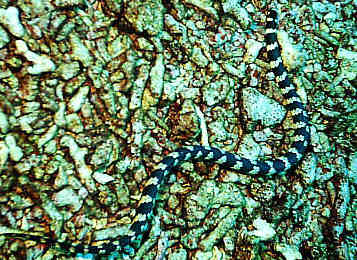

- JAPANESE NAME : Iijima-Umi-Hebi
- COMMON NAME : Ijima's turtle-headed sea snake
- SCIENTIFIC NAME : Emydocephalus ijimae
- LENGTH : 50 - 90cm
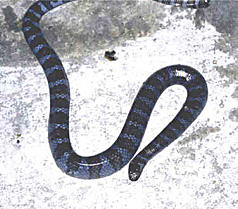
- JAPANESE NAME : Erabu-Umi-Hebi
- COMMON NAME : Erabu sea snake
- SCIENTIFIC NAME : Laticauda semifasciata
- LENGTH : 70 - 150cm
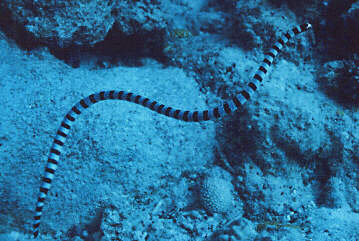
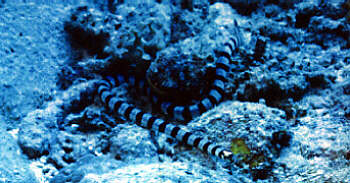
- JAPANESE NAME : Ao-Madara-Umi-Hebi
- COMMON NAME : Yellow-lipped sea snake
- SCIENTIFIC NAME : Laticauda colubrina
- LENGTH : 80 - 150cm
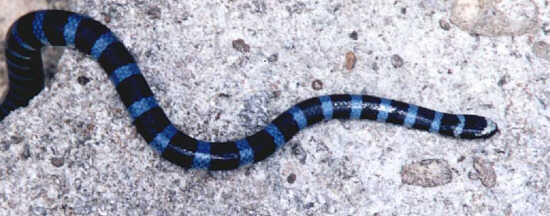
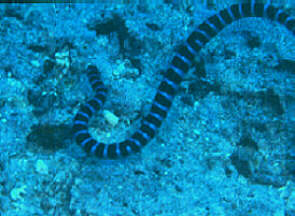
- JAPANESE NAME : Hiroo-Umi-Hebi
- COMMON NAME : Banded amphibious sea snake
- SCIENTIFIC NAME : Laticauda laticaudata
- LENGTH : 70 - 150cm
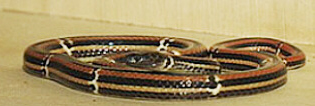
- JAPANESE NAME : Hai
- COMMON NAME : Hai (Okinawa) coral snake
- SCIENTIFIC NAME : Calliophis japonicus boettgeri
- LENGTH : 70 - 150cm
